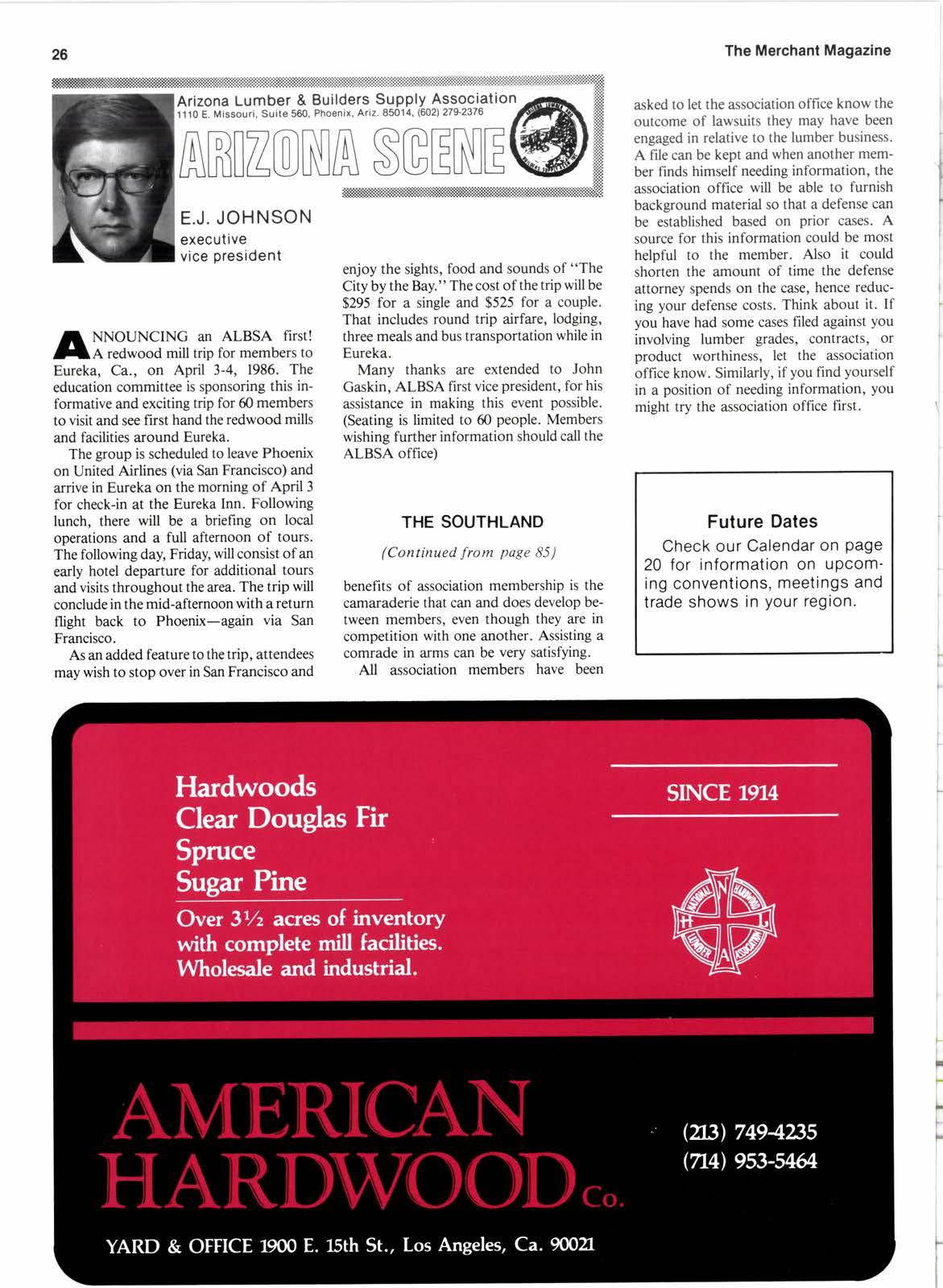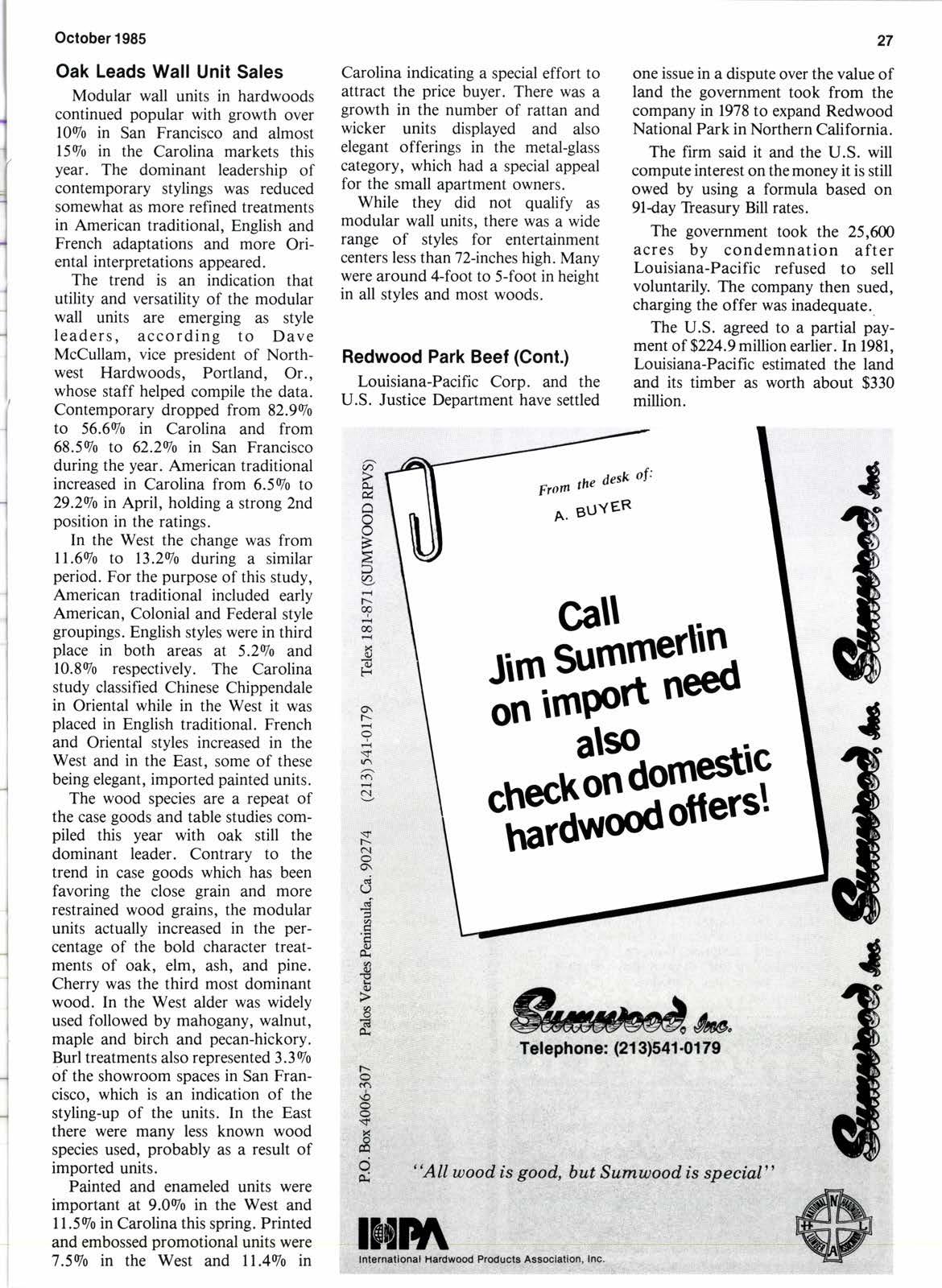
4 minute read
ARIZONA SGENI
E.J. JOHNSON executive vice oresident
I NNOUNCINC an ALBSA first!
lIA redwood mill trip for members to Eureka, Ca., on April 3-4, 1986. The education committee is sponsoring this informative and exciting trip for 60 members to visit and see lust hand the redwood mills and facilities around Eureka.
The group is scheduled to leave Phoenix on United Airlines (via San Francisco) and arrive in Eureka on the morning of April 3 for check-in at the Eureka Inn. Following lunch, there will be a briefing on local operations and a full afternoon of tours. The following day, Friday, will consist of an early hotel departure for additional tours and visits throughout the area. The trip will conclude in the mid-afternoon with a return flight back to Phoenix-again via San Francisco.
As an added feature to the trip, attendees may wish to stop over in San Francisco and enjoy the sights, food and sounds of "The City by the Bay." The cost of the trip will be $295 for a single and $525 for a couple. That includes round trip airfare, lodging, three meals and bus transportation while in Eureka.
Many thanks are extended to John Gaskin, ALBSA first vice president, for his assistance in making this event possible. (Seating is limited to 60 people. Members wishing further information should call the ALBSA office)
The Southland
(Continued from page 85) benefits of association membership is the camaraderie that can and does develop between members, even though they are in competition with one another. Assisting a comrade in arms can be very satisfying.
All association members have been j@asked to let the association office know the outcome of lawsuits they may have been engaged in relative to the lumber business. A file can be kept and when another member finds himself needing information, the association office will be able to furnish background material so that a defense can be established based on prior cases. A source for this information could be most helpful to the member. Also it could shorten the amount of time the defense attorney spends on the case, hence reducing your defense costs. Think about it. If you have had some cases filed against you involving lumber grades, contracts, or product worthiness, let the association office know. Similarly, if you find yourself in a position of needing information, you might try the association office first.
Future Dates
Check our Calendar on Page 2Q tor information on upcoming conventions, meetings and trade shows in your region.
Oak Leads Wall Unit Sales
Modular wall units in hardwoods continued popular with growth over l09o in San Francisco and almost l59o in the Carolina markets this year. The dominant leadership of contemporary stylings was reduced somewhat as more refined treatments in American traditional, English and French adaptations and more Oriental interpretations appeared.
The trend is an indication that utility and versatility of the modular wall units are emerging as style leaders, according to Dave McCullam, vice president of Northwest Hardwoods, Portland, Or., whose staff helped compile the data. Contemporary dropped from 82.990 b 56.6q0 in Carolina and from 68.590 to 62.2v/o in San Francisco during the year. American traditional increased in Carolina from 6.590 to 29.20/o in April, holding a strong 2nd position in the ratings.
In the West the change was from ll.69o to 13.2t/o during a similar period. For the purpose of this study, American traditional included early American, Colonial and Federal style groupings. English styles were in third place in both areas at 5.20/o and 10.890 respectively. The Carolina study classified Chinese Chippendale in Oriental while in the West it was placed in English traditional. French and Oriental styles increased in the West and in the East, some of these being elegant, imported painted units.
The wood species are a repeat of the case goods and table studies compiled this year with oak still the dominant leader. Contrary to the trend in case goods which has been favoring the close grain and more restrained wood grains, the modular units actually increased in the percentage of the bold character treatments of oak, elm, ash, and pine. Cherry was the third most dominant wood. In the West alder was widely used followed by mahogany, walnut, maple and birch and pecan-hickory. Burl treatments also represented 3.390 of the showroom spaces in San Francisco, which is an indication of the styling-up of the units. In the East there were many less known wood species used, probably as a result of imported units.
Painted and enameled units were important at 9.0s/o in the West and I1.590 in Carolina this spring. Printed and embossed promotional units were 7.5s/o in the West and ll.49o in
Carolina indicating a special effort to attract the price buyer. There was a growth in the number of rattan and wicker units displayed and also elegant offerings in the metal-glass category, which had a special appeal for the small apartment owners.
While they did not qualify as modular wall units, there was a wide range of styles for entertainment centers less than 72-inches high. Many were around 4-foot to 5-foot in height in all styles and most woods.
Redwood Park Beef (Cont.)
Louisiana-Pacific Corp. and the U.S. Justice Department have settled one issue in a dispute over the value of land the government took from the company in 1978 to expand Redwood National Park in Northern California.

The firm said it and the U.S. will compute interest on themoney it is still owed by using a formula based on 9lday Tieasury Bill rates.
The government took the 25,600 acres by condemnation after Louisiana-Pacific refused to sell voluntarily. The company then sued, charging the offer was inadequate..
The U.S. agreed to a partial payment of $22.9 million earlier. In 1981, Louisiana-Pacific estimated the land and its timber as worth about $330 million.










